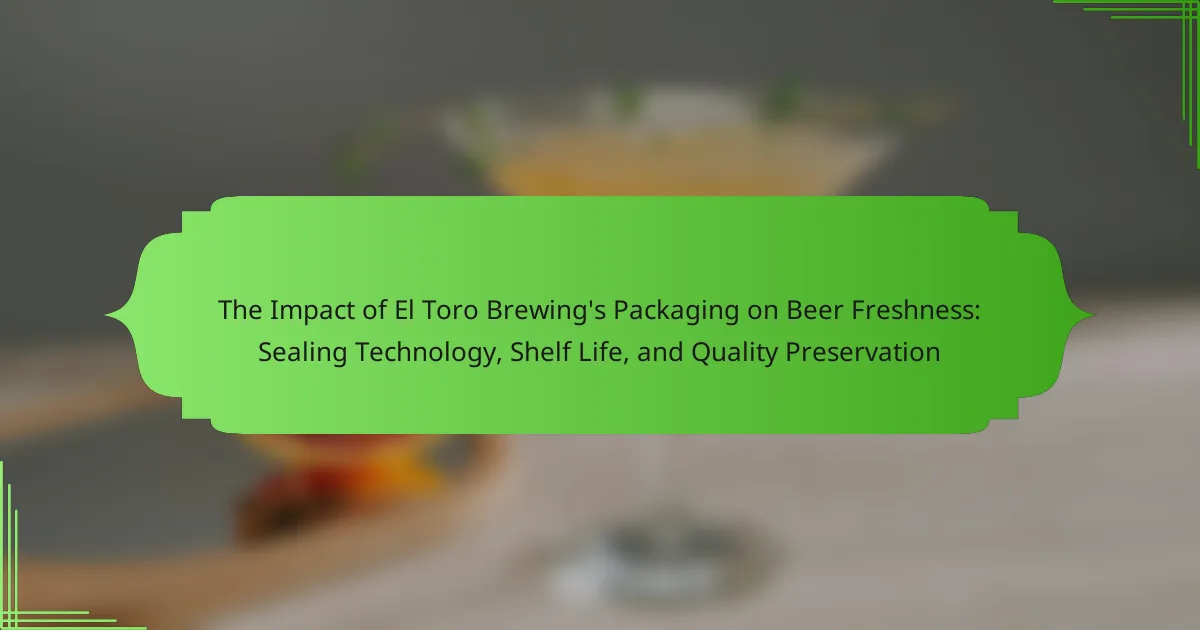El Toro Brewing is a brewery that employs various labeling techniques to enhance brand identity and ensure compliance with regulatory standards. Their labels prominently feature the brewery’s logo, vibrant colors, and distinctive typography, which attract consumer attention while including essential information such as alcohol content and ingredient lists. The brewery’s approach combines creativity with adherence to federal and state labeling requirements, establishing trust with consumers. Additionally, El Toro Brewing incorporates storytelling elements on their labels to engage consumers emotionally, reinforcing brand loyalty and differentiating their products in a competitive market. Effective labeling strategies, including the use of high-quality materials, contribute to consumer engagement and increased purchase intent.

What are El Toro Brewing’s Labeling Techniques?
El Toro Brewing employs a variety of labeling techniques to enhance brand identity and ensure compliance. Their labels prominently feature the brewery’s logo, which creates instant brand recognition. They utilize vibrant colors and distinctive typography to attract consumer attention. The labels also include essential information such as alcohol content and ingredients, adhering to regulatory requirements. Additionally, El Toro Brewing incorporates storytelling elements on their labels to engage consumers emotionally. This approach helps convey the unique characteristics of each brew. The use of high-quality materials adds a tactile element, reinforcing the premium nature of their products. These techniques collectively contribute to effective consumer engagement and brand loyalty.
How do these techniques ensure compliance with regulations?
Labeling techniques ensure compliance with regulations by adhering to specific legal requirements set by governing bodies. These techniques include accurate ingredient listings, clear nutritional information, and proper allergen disclosures. Compliance is verified through regular audits and reviews of labeling practices. For instance, the Alcohol and Tobacco Tax and Trade Bureau (TTB) mandates that labels must not mislead consumers. Additionally, following standards from the Food and Drug Administration (FDA) ensures that all health claims are substantiated. This systematic approach to labeling mitigates the risk of violations and enhances consumer trust.
What specific regulations govern labeling in the brewing industry?
The specific regulations governing labeling in the brewing industry include the Alcohol and Tobacco Tax and Trade Bureau (TTB) guidelines. These regulations require accurate representation of the product, including alcohol content and ingredients. Labels must not mislead consumers about the nature or quality of the beverage. The TTB mandates that labels include the name and address of the manufacturer. Additionally, state regulations may impose further requirements on labeling practices. Compliance with these regulations ensures consumer safety and product integrity.
How does El Toro Brewing stay updated on labeling compliance?
El Toro Brewing stays updated on labeling compliance by regularly consulting industry regulations. They monitor updates from the Alcohol and Tobacco Tax and Trade Bureau (TTB). The brewery also engages with legal experts specializing in labeling laws. Additionally, they participate in industry workshops and seminars. These activities help them understand the latest compliance requirements. They also review competitor labeling practices for insights. This proactive approach ensures their labels meet all legal standards.
What design trends are evident in El Toro Brewing’s labels?
El Toro Brewing’s labels exhibit a blend of modern minimalism and vibrant color palettes. The use of bold typography is prominent, enhancing brand recognition. Illustrative elements often reflect local culture and ingredients, creating a unique identity. Additionally, eco-friendly materials are increasingly used, aligning with sustainability trends. The overall design emphasizes clarity and visual appeal to attract consumers. These trends are consistent with current industry practices aimed at enhancing shelf presence and consumer engagement.
How do color schemes influence consumer perception?
Color schemes significantly influence consumer perception by affecting emotions and brand recognition. Research shows that colors can evoke specific feelings and associations. For instance, blue often conveys trust, while red can stimulate excitement. A study by the Institute for Color Research found that people make a subconscious judgment about products within 90 seconds based on color alone. Additionally, consistent color use enhances brand recognition by up to 80%. Therefore, effective color schemes can shape consumer attitudes and purchasing decisions.
What role does typography play in label design?
Typography plays a crucial role in label design. It influences readability, brand identity, and consumer perception. Effective typography enhances clarity and ensures that essential information is easily understood. Different font styles convey distinct emotions and brand messages. For example, serif fonts often suggest tradition and reliability, while sans-serif fonts appear modern and clean. Research shows that well-chosen typography can increase product recognition by up to 50%. Additionally, typography impacts shelf appeal, influencing purchasing decisions. Therefore, thoughtful typography is essential for creating impactful labels that resonate with consumers.
How does El Toro Brewing engage consumers through labeling?
El Toro Brewing engages consumers through labeling by using eye-catching designs and informative content. Their labels feature vibrant colors and unique artwork that attract attention on store shelves. Each label includes detailed descriptions of the beer’s flavor profile and ingredients. This transparency helps consumers make informed choices. Additionally, El Toro Brewing often incorporates storytelling elements related to the brand’s history or the brewing process. This creates a personal connection with consumers. The use of QR codes on labels allows consumers to access more information digitally. This interactive approach enhances consumer engagement and builds brand loyalty. Overall, their labeling strategy effectively combines aesthetics with informative content.
What interactive elements are used on labels to attract attention?
Interactive elements on labels that attract attention include QR codes, augmented reality features, and tactile textures. QR codes allow consumers to access additional information or promotions by scanning with their smartphones. Augmented reality features can enhance the label experience by providing visual content when viewed through a compatible app. Tactile textures, such as embossing or soft-touch finishes, create a sensory experience that engages consumers physically. These elements have been shown to increase consumer interaction and brand recall. Research indicates that labels incorporating interactive features can lead to higher purchase intent and engagement rates.
How do labels communicate brand values and story?
Labels communicate brand values and story through visual design, messaging, and material choice. The design elements, such as colors and fonts, evoke specific emotions and associations. For instance, earthy tones may convey sustainability, while vibrant colors suggest energy. Messaging on labels articulates the brand’s mission and values, often highlighting key selling points like organic ingredients or local sourcing. The choice of materials can also reflect brand ethos; eco-friendly packaging signals environmental responsibility. Research shows that consumers often make purchasing decisions based on label impressions, reinforcing the importance of effective label communication. Brands like El Toro Brewing utilize these techniques to create a cohesive narrative that resonates with their target audience.

How does El Toro Brewing balance compliance and creativity in labeling?
El Toro Brewing balances compliance and creativity in labeling by adhering to regulatory guidelines while incorporating unique design elements. The brewery ensures that all labels meet federal and state labeling requirements, including ingredient disclosure and alcohol content. This compliance establishes trust with consumers and regulatory bodies. Simultaneously, El Toro Brewing employs innovative graphics and storytelling on their labels to attract attention and convey brand identity. The combination of regulatory adherence and creative expression enhances consumer engagement. By successfully merging these aspects, El Toro Brewing differentiates its products in a competitive market.
What challenges does El Toro Brewing face in label design?
El Toro Brewing faces challenges in label design related to regulatory compliance, brand differentiation, and consumer appeal. Regulatory compliance requires adherence to specific labeling laws, which can vary by region. This includes accurate ingredient listings and health warnings. Brand differentiation is crucial in a competitive market, necessitating unique designs that stand out on shelves. Consumer appeal involves creating visually attractive labels that resonate with target demographics. Balancing these elements can complicate the design process for El Toro Brewing.
How do regulations limit creative expression in labeling?
Regulations limit creative expression in labeling by imposing strict guidelines on content and design. These regulations often require specific information, such as ingredient lists and health warnings. This necessity can restrict the use of artistic elements and branding techniques. Additionally, regulations may dictate font size, color contrast, and placement of mandatory information. Such constraints can hinder a brand’s ability to convey its unique identity. For example, the Alcohol and Tobacco Tax and Trade Bureau (TTB) mandates certain labeling requirements for alcoholic beverages. Compliance with these rules can reduce the scope of innovative design. As a result, brands may struggle to differentiate themselves in a competitive market.
What strategies does El Toro Brewing use to overcome these challenges?
El Toro Brewing uses innovative labeling designs to enhance consumer engagement. They prioritize compliance with industry regulations to avoid legal challenges. The brewery employs market research to understand design trends and consumer preferences. They also utilize high-quality materials for labeling to ensure durability and appeal. Regular feedback from customers helps them adapt their strategies effectively. Collaborations with local artists create unique label designs that attract attention. Additionally, they invest in digital marketing to promote their products and educate consumers about labeling. These strategies collectively help El Toro Brewing navigate challenges in the competitive brewing market.
How can consumers influence labeling trends in the brewing industry?
Consumers can influence labeling trends in the brewing industry through their preferences and purchasing behaviors. When consumers prioritize transparency, breweries respond by adopting clearer labeling practices. For instance, the rise of craft beer has led to increased demand for unique and informative labels. Studies show that 70% of consumers read labels before purchasing beer. This trend pressures breweries to innovate their designs and provide detailed ingredient information. Social media also amplifies consumer voices, encouraging breweries to align with popular design trends. As consumers advocate for sustainability, breweries increasingly highlight eco-friendly packaging on labels. These factors collectively shape the evolving landscape of labeling in the brewing industry.
What feedback mechanisms does El Toro Brewing use to gather consumer insights?
El Toro Brewing utilizes several feedback mechanisms to gather consumer insights. They conduct surveys to collect direct feedback from customers. These surveys often focus on product satisfaction and preferences. Additionally, El Toro Brewing engages with consumers through social media platforms. They monitor comments and messages for insights on consumer opinions. The brewery also hosts tasting events to gather real-time feedback on new products. Customer reviews on retail websites are analyzed for trends and areas of improvement. These methods collectively enhance El Toro Brewing’s understanding of consumer needs and preferences.
How does consumer feedback shape future labeling designs?
Consumer feedback significantly influences future labeling designs. Companies analyze feedback to identify consumer preferences and pain points. This analysis informs design choices such as color, typography, and imagery. For example, if consumers express confusion about ingredient lists, brands may simplify their labels. Research shows that 70% of consumers prefer clear, straightforward labels. Incorporating this feedback can enhance consumer trust and satisfaction. Ultimately, consumer insights drive innovation in labeling, ensuring designs meet market demands.

What best practices can be adopted for effective labeling in brewing?
Effective labeling in brewing requires clarity, compliance, and creativity. Labels must clearly state the product name, style, and alcohol content. Compliance with local regulations is crucial for safety and legal standards. Including ingredient lists and allergen information enhances transparency. Design should attract consumers while reflecting the brand’s identity. Utilizing high-quality materials ensures durability and visibility. Engaging storytelling can connect with consumers emotionally. Research shows that well-designed labels can increase purchase intent by up to 70%.
What key elements should be included in a successful label design?
A successful label design should include clear branding, essential product information, and eye-catching graphics. Clear branding establishes identity and helps consumers recognize the product. Essential product information includes ingredients, volume, and any required legal disclaimers. Eye-catching graphics attract attention and can convey the product’s theme or flavor. Additionally, color choice impacts consumer perception and can influence buying decisions. Typography must be legible and align with the brand’s voice. Compliance with labeling regulations ensures the product meets legal standards. Together, these elements create an effective label that engages consumers and communicates key information.
How can clarity and simplicity enhance label effectiveness?
Clarity and simplicity enhance label effectiveness by making information easily accessible to consumers. Clear labels allow consumers to quickly understand product details. Simplicity reduces cognitive load, helping consumers make informed choices faster. According to a study by the Journal of Marketing Research, simple designs improve consumer recall. This is crucial in a competitive market where attention spans are short. Effective labels communicate essential attributes without overwhelming the consumer. Research indicates that clear labeling can increase purchase intent by up to 30%. Overall, clarity and simplicity are key to successful product labeling.
What role does storytelling play in label design?
Storytelling plays a crucial role in label design by creating an emotional connection with consumers. It helps convey the brand’s values, heritage, and product uniqueness. Effective storytelling on labels can enhance consumer engagement and brand loyalty. For instance, labels that narrate the brewing process or the origin of ingredients resonate more with customers. This approach can lead to increased sales. Research shows that products with compelling narratives can outperform those without by up to 20%. Thus, storytelling is essential for differentiating products in a crowded market.
What are common pitfalls to avoid in labeling?
Common pitfalls to avoid in labeling include unclear messaging, non-compliance with regulations, and poor design choices. Unclear messaging can confuse consumers and diminish brand trust. Non-compliance with labeling regulations can result in legal penalties and product recalls. Poor design choices may lead to a lack of consumer engagement and reduced sales. Additionally, failing to accurately represent product contents can mislead customers, affecting brand reputation. Effective labeling should prioritize clarity, compliance, and appealing design to enhance consumer understanding and engagement.
How can misleading information impact brand reputation?
Misleading information can severely damage brand reputation. It creates distrust among consumers. When a brand is associated with false claims, customers may feel deceived. This can lead to negative reviews and social media backlash. A study by the University of Massachusetts found that 70% of consumers would avoid a brand after encountering misleading information. Additionally, brands may face legal repercussions for false advertising. This can result in costly lawsuits and fines. Ultimately, a tarnished reputation can lead to decreased sales and customer loyalty.
What are the consequences of non-compliance in labeling?
Non-compliance in labeling can lead to significant legal and financial repercussions. Companies may face fines imposed by regulatory authorities. These fines can vary based on the severity of the violation. Additionally, non-compliance can result in product recalls, which incur further costs. Consumers may also lose trust in the brand, affecting sales and market reputation. In some cases, companies may face lawsuits from affected consumers. Regulatory agencies may increase scrutiny on future products, leading to stricter oversight. Overall, non-compliance can severely impact a company’s operational viability and profitability.
El Toro Brewing is a craft brewery that employs innovative labeling techniques to enhance brand identity and ensure compliance with industry regulations. The article explores the various aspects of their labeling approach, including design trends, the importance of color schemes and typography, and how these elements engage consumers. It also addresses the regulatory landscape governing labeling in the brewing industry, the challenges faced by El Toro Brewing, and strategies used to balance compliance with creativity. Additionally, the article highlights the role of consumer feedback in shaping labeling practices and identifies best practices for effective label design.


